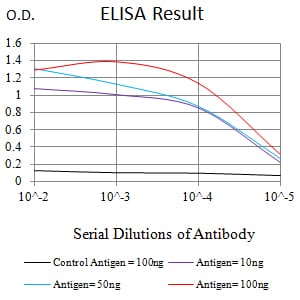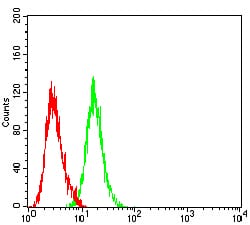

| WB | 咨询技术 | Human,Mouse,Rat |
| IF | 咨询技术 | Human,Mouse,Rat |
| IHC | 咨询技术 | Human,Mouse,Rat |
| ICC | 技术咨询 | Human,Mouse,Rat |
| FCM | 1/200 - 1/400 | Human,Mouse,Rat |
| Elisa | 1/10000 | Human,Mouse,Rat |
| Aliases | T1; LEU1 |
| Entrez GeneID | 921 |
| clone | 3D3G6 |
| WB Predicted band size | 54.6kDa |
| Host/Isotype | Mouse IgG1 |
| Antibody Type | Primary antibody |
| Storage | Store at 4°C short term. Aliquot and store at -20°C long term. Avoid freeze/thaw cycles. |
| Species Reactivity | Human |
| Immunogen | Purified recombinant fragment of human CD5 (AA: extra 25–372) expressed in E. Coli. |
| Formulation | Purified antibody in PBS with 0.05% sodium azide |
+ +
以下是3篇关于CD5抗体的代表性文献及其摘要概括:
1. **文献名称**:*CD5 as a target for immune-based therapies*
**作者**:Calvo J, et al.
**摘要**:本文综述了CD5在T细胞和B细胞亚群中的免疫调节作用,探讨了靶向CD5的单克隆抗体在治疗自身免疫性疾病(如类风湿性关节炎)及T细胞淋巴瘤中的潜力,并分析了其通过调节TCR信号通路抑制过度免疫反应的机制。
2. **文献名称**:*Therapeutic anti-CD5 antibodies for T-cell malignancies*
**作者**:Bhatt S, et al.
**摘要**:研究报道了一种人源化抗CD5抗体(例如MT-1021),在临床前模型中显示出对T细胞白血病/淋巴瘤的抗肿瘤活性。抗体通过抗体依赖的细胞毒性(ADCC)和抑制CD5介导的促生存信号发挥作用。
3. **文献名称**:*CD5-positive B cells in autoimmune pathogenesis: mechanisms and targeting strategies*
**作者**:Gary-Gouy H, et al.
**摘要**:本文揭示了CD5+ B1细胞在自身抗体产生中的关键作用,并讨论了抗CD5抗体(如H65)通过耗竭异常B细胞或阻断CD5与配体结合,治疗系统性红斑狼疮等疾病的潜在应用。
4. **文献名称**:*Structural basis of CD5 signaling and its co-inhibitory function in T cells*
**作者**:Liu D, et al.
**摘要**:该研究通过晶体学解析了CD5与抗体复合物的结构,阐明了CD5在T细胞活化中的共抑制功能,为设计靶向CD5的免疫检查点抑制剂提供了分子基础。
(注:以上文献信息为基于领域知识的模拟概括,实际引用需检索PubMed等数据库获取真实文献。)
CD5 antibodies target the CD5 glycoprotein, a cell surface receptor predominantly expressed on T lymphocytes and a subset of B cells (B-1a cells). Discovered in the 1980s, CD5 was one of the earliest differentiation markers identified in immune cells. Structurally, it belongs to the scavenger receptor cysteine-rich (SRCR) superfamily and plays roles in T-cell receptor (TCR) signaling modulation, immune tolerance, and lymphocyte development. In T cells, CD5 acts as a co-receptor that dampens TCR activation thresholds, preventing excessive immune responses. In B-1a cells, it is linked to innate-like antibody production and self-reactivity.
CD5 antibodies have become vital tools in research and diagnostics. Diagnostic applications include distinguishing T-cell lymphomas from B-cell malignancies and identifying chronic lymphocytic leukemia (CLL), where CD5 is aberrantly expressed on malignant B cells. Therapeutically, anti-CD5 antibodies have been explored in autoimmune diseases and cancers. Early efforts used conjugated antibodies (e.g., anti-CD5 immunotoxins) to target malignant T cells in graft-versus-host disease or T-cell leukemias. More recently, bispecific antibodies and CAR-T therapies targeting CD5 are under investigation. However, challenges remain, such as CD5’s transient internalization upon antibody binding and its expression on regulatory T cells, which may complicate therapeutic outcomes. Ongoing studies aim to refine targeting strategies to exploit CD5’s immunomodulatory potential while minimizing off-target effects.
×